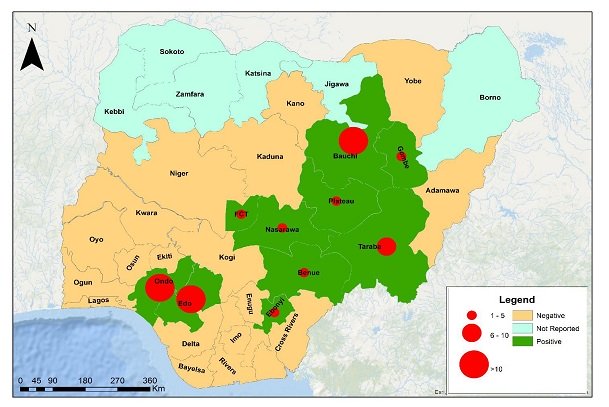 Wash your hands regularly and wear a face mask.
Learn more
Wash your hands regularly and wear a face mask.
Learn more

The Nigeria Centre for Disease Control and Prevention (NCDC) has activated a national multisectoral Emergency Operations Centre for Lassa Fever so as to coordinate and strengthen ongoing response activities in the country.
Status of Lassa Fever 2023
According to the Nigeria Centre for Disease Control (NCDC), 3,272 suspected cases, and 676 confirmed cases, and 144 deaths were reported as of 26th March 2023. In these reports, seventy-two (72%) of all confirmed Lassa Fever cases were reported from three (3) states namely Ondo State (1,049 suspected cases, 262 confirmed cases, and 30 deaths); Edo State (1,423 suspected cases, 238 confirmed cases, and 30 deaths); while Bauchi states have (589 suspected cases, 92 confirmed cases, and 15 deaths). And the rest are from 32 other states and FCT (97 LGAs) which include:
The predominantly affected age group is between 21-30 years. Three (3) new healthcare worker was reported to have been affected by the disease per the report, making a total of 38 healthcare workers affected since its outbreak in 2023.
According to reports, 37 patients are currently being managed at all Lassa fever treatment centers nationwide, while 498 persons are being followed up.
What is Lassa Fever?
Lassa fever (LF) is an acute viral illness and a viral haemorrhagic fever (VHF). It is a zoonotic disease that has caused high mortality cases in Nigeria. The illness was first reported in the Lassa community in Borno State, Nigeria when two missionary nurses died from an unusual febrile illness. Since then, cases and outbreaks continue to be reported in Nigeria and the disease is increasingly recognized to be endemic in many parts of West Africa, including Nigeria, Benin, Ghana, Mali, and the Mano River region (Sierra Leone, Liberia, and Guinea), with the disease probably existing in other West African countries as well.
How Lassa Fever Is Contracted and Managed
Lassa Fever is transmitted to humans via contaminated food or water with infected rats’ urine or faeces. Person-to-person transmission may occur after exposure to the virus in a Lassa virus-infected individual's blood, tissue, secretions, or excretions. In hospitals lacking adequate infection control measures, person-to-person infections can infect health workers.
Primary transmission of the Lassa virus from its host to humans can be prevented by avoiding contact with Mastomys rats, putting food away in rodent-proof containers, and keeping the home clean help to discourage rodents from entering homes. When looking after patients with Lassa fever, further transmission of the disease through person-to-person contact can be avoided by taking preventive precautions against contact with patient secretions.
Symptoms of Lassa fever resemble those of malaria. However, in severe cases, bleeding from the mouth, nose, and gastrointestinal tract occurs, hence it is called haemorrhagic fever.
Lassa fever is diagnosed in special centers nationwide, e.g., Irrua Specialist Hospital, Edo State, Lagos University Teaching Hospital, etc.
Ribavirin, an antiviral drug, has been used with success in Lassa fever patients. Patients should also receive early supportive care with rehydration and symptomatic treatment.